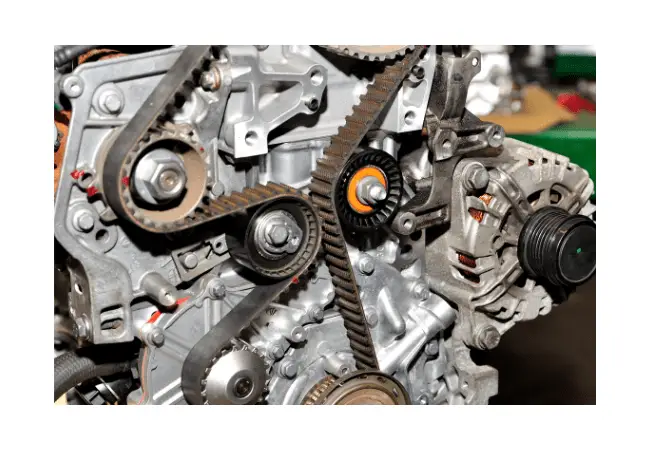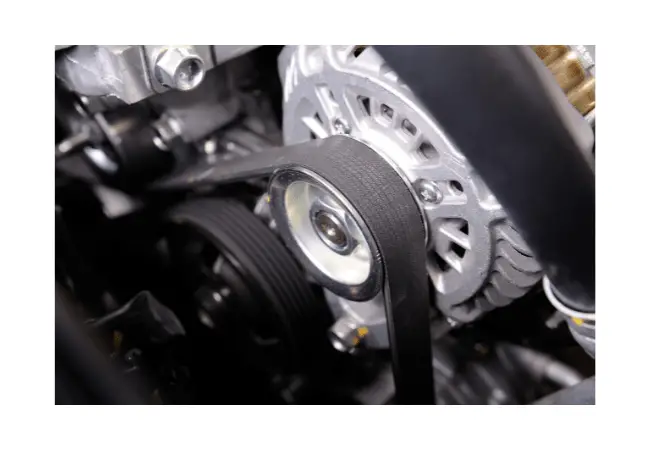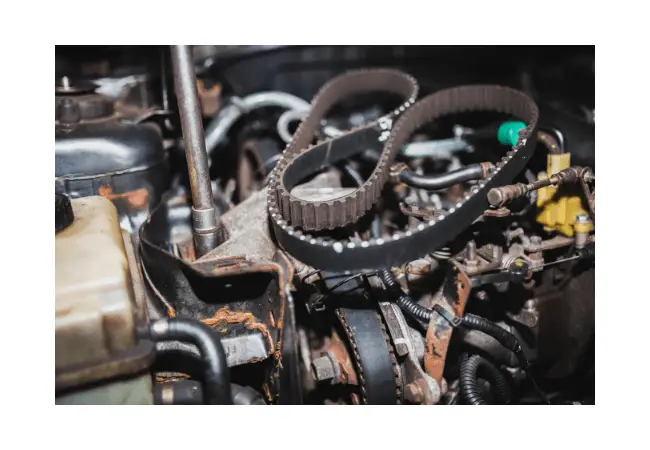Understanding the Serpentine Belt and its proper tension is essential for the smooth functioning of a vehicle’s engine. The serpentine belt, also known as the drive belt, plays a crucial role in powering various engine components such as the alternator, power steering pump, water pump, and air conditioning compressor. It’s important to maintain the correct tension and know how tight should serpentine belt be to prevent any potential issues.
The serpentine belt should be tight enough to prevent any slippage but not so tight that it places undue stress on the pulleys and bearings of the accessories it drives. A properly tensioned belt will have a bit of give when you push on it with moderate force, typically deflecting about half an inch to an inch. Over-tightening can lead to premature wear of the belt and pulley bearings, while a belt that’s too loose can cause slippage, leading to inefficient operation of the accessories, squealing noises, and potential overheating. Therefore, striking the right balance in its tightness is paramount to ensure the longevity of the belt and the proper functioning of the components it drives.
Checking the tension of a serpentine belt is relatively simple and can be done using two methods. The first method involves using the belt deflection method, where the belt’s deflection is measured by pressing down on it with a specified amount of force. The second method involves using a tension gauge to measure the tension directly.
The ideal tension for a serpentine belt depends on the manufacturer’s specifications and the specific vehicle model. The recommended belt tension measurement is typically provided by the manufacturer and can vary. Similarly, the acceptable belt deflection amount, which is the amount the belt can be pushed down or deflected, also varies based on manufacturer recommendations.

Recognizing the signs of an incorrectly tensioned serpentine belt is crucial for timely adjustments. Common signs include squealing or chirping noises, belt slippage, visible wear or cracks on the belt, or poor performance of engine components.
To properly adjust the tension of a serpentine belt, a systematic process should be followed. This involves first loosening the belt pulley, then adjusting the belt tension to meet the manufacturer’s specifications, and finally, tightening the belt pulley to secure the belt in place.
Ensuring the proper tension of a serpentine belt is essential for the reliable operation of a vehicle’s engine. By understanding its importance, knowing how to check and adjust the tension, and recognizing the signs of incorrect tension, vehicle owners can maintain a well-functioning and efficient engine system.
Jump To
- 1 Key takeaways:
- 2 Understanding the Serpentine Belt
- 3 Importance of Proper Tension
- 4 How to Check the Tension of a Serpentine Belt?
- 5 What Should be the Ideal Tension for a Serpentine Belt?
- 6 Common Signs of an Incorrectly Tensioned Serpentine Belt
- 7 How to Properly Adjust the Tension of a Serpentine Belt?
- 8 Some Facts About How Tight Serpentine Belt Should Be:
- 9 Frequently Asked Questions
- 9.1 How tight should serpentine belt be?
- 9.2 What are some preliminary checks to do before tightening a serpentine belt?
- 9.3 Can a tight serpentine belt damage other engine components?
- 9.4 Should the tensioner on the alternator belt be extremely tight?
- 9.5 What is the sweet spot for serpentine belt tension?
- 9.6 Can a serpentine belt be easily replaced if it malfunctions?
Key takeaways:
- Proper tension is crucial for a serpentine belt: If the belt is too loose, it may slip or fail to operate various engine components, leading to potential damage. On the other hand, an overly tight belt can strain the components and cause premature wear.
- Methods to check belt tension: Two commonly used methods include the belt deflection method and the use of a tension gauge. These techniques help determine whether the belt is within the recommended tension range.
- Ideal tension and recommended measurements: The ideal tension for a serpentine belt varies depending on the vehicle and manufacturer’s specifications. It is important to follow the recommended belt tension measurement and belt deflection amount provided in the vehicle’s manual to ensure proper functioning.
Understanding the Serpentine Belt
The understanding of the serpentine belt is crucial for maintaining the performance and longevity of your vehicle. The serpentine belt, responsible for driving multiple components such as the alternator, power steering pump, and air conditioning compressor, is an essential part of a vehicle’s engine system. Proper tension is necessary for efficient operation, ensuring that the belt is neither too loose nor too tight. Regularly inspect the serpentine belt for signs of wear or damage, and replace it as recommended by the manufacturer to avoid unexpected breakdowns.
Importance of Proper Tension
The importance of maintaining the correct tension of a serpentine belt cannot be overstated. It is crucial for the smooth operation of a vehicle and the efficient power transmission to its engine components. When the belt is too loose, it may slip and fail to effectively drive the necessary engine components. Conversely, if the belt is too tight, it can strain the pulley system, potentially causing premature wear and damage. Therefore, ensuring proper tension is essential to keep the belt in place, prevent costly repairs, and enable long-term performance. Regular inspection and adjustment of the serpentine belt tension are vital for vehicle maintenance.
What Happens if the Serpentine Belt is Too Loose?
If the serpentine belt is too loose, What Happens if the Serpentine Belt is Too Loose? several issues can arise. The belt may slip or come off the pulleys, resulting in the loss of power to essential components such as the alternator, water pump, or power steering pump. This can lead to battery drainage, engine overheating, or loss of steering control. A loose belt may produce squealing or chirping noises, indicating insufficient tension. Regular inspection and adjustment of the belt tension are crucial for optimal performance and to prevent premature belt failure.
What Happens if the Serpentine Belt is Too Tight?
If the serpentine belt is too tight, What Happens if the Serpentine Belt is Too Tight? it can cause various issues in the functioning of your vehicle. These include excessive stress on the belt and its components, reduced lifespan of the belt, and potential damage to other engine components like the tensioner and pulleys. A tight belt can also result in increased resistance, leading to decreased engine performance and fuel efficiency. The increased tension can cause a squealing noise and excessive wear on the belt, leading to premature failure. It is important to ensure that the serpentine belt is properly tensioned to avoid these problems and maintain optimal performance.
How to Check the Tension of a Serpentine Belt?

With so much riding on the performance of your serpentine belt, it’s crucial to ensure that its tension is just right. In this section, we’ll dive into two methods you can use to check the tension of your serpentine belt. Whether you prefer the belt deflection method or the precision of a tension gauge, we’ve got you covered. Get ready to learn the tricks of the trade and keep your engine running smoothly.
Method 1: Using the Belt Deflection Method
To check the tension of a serpentine belt using Method 1: the Belt Deflection Method, follow these steps:
- Position yourself in front of the engine with the hood open.
- Locate the belt tensioner, which is usually a pulley attached to an arm.
- Use a socket wrench or a belt tensioner tool to rotate the tensioner in the direction that loosens the belt.
- Once the belt is loose, push down on the longest section of the belt with your thumb.
- Measure the amount of deflection by comparing it to the manufacturer’s specifications.
- If the deflection is within the recommended range, the tension is correct. If not, adjustment may be necessary.
Using Method 1: The belt Deflection Method is a simple and effective way to ensure that the serpentine belt is properly tensioned.
Method 2: Using a Tension Gauge
To accurately check the tension of a serpentine belt, you can use a tension gauge. Here are the steps to do it:
- Locate the tensioner pulley and identify the specific adjustment bolt or pulley that should be used with the tension gauge.
- Method 2: Using a Tension Gauge, attach the tension gauge to the designated spot on the tensioner pulley or adjustment bolt.
- Slowly apply tension with the gauge until it reads the recommended tension measurement for your specific vehicle.
- If the tension is too loose, adjust the belt using the appropriate adjustment mechanism until the desired tension is achieved.
- If the tension is too tight, loosen the belt by releasing tension from the tensioner pulley or adjustment bolt.
- Once the tension is correctly set, remove the tension gauge and secure the belt tension by tightening any bolts or pulleys that were used for adjustments.
Pro-tip: Regularly checking and adjusting the tension of your serpentine belt can help prolong its lifespan and ensure optimal performance of your vehicle’s accessories.
What Should be the Ideal Tension for a Serpentine Belt?
The ideal tension for a serpentine belt is crucial for optimal performance and longevity. What Should be the Ideal Tension for a Serpentine Belt? It is recommended to follow the manufacturer’s specifications for the specific make and model of your vehicle. Generally, the belt should have enough tension to prevent slipping while allowing for proper rotation. Over-tensioning can cause stress on the belt and other components, leading to premature wear. Under-tensioning can result in belt slip, affecting the functioning of the vehicle’s accessories. Regular inspection and adjustment of the belt tension is essential to ensure it is within the ideal range for maximum efficiency and durability.
What is the Recommended Belt Tension Measurement?
The recommended belt tension measurement for a serpentine belt is typically specified by the manufacturer of the vehicle or engine. What is the Recommended Belt Tension Measurement? It is usually given in units of force, such as pounds or Newtons, and is based on the specific design and requirements of the belt system. The tension should be set within a specific range to ensure optimal performance and longevity of the belt. Improper tension can lead to various issues, such as slipping, excessive wear, and even component failure. To accurately measure and adjust the tension, it is recommended to refer to the vehicle or engine’s service manual or consult a professional mechanic.
What Should be the Belt Deflection Amount?
The ideal belt deflection amount for a serpentine belt depends on the length and width of the belt. What Should be the Belt Deflection Amount? It is generally recommended to have a belt deflection of around 1/4 to 1/2 inch for belts with a length of up to 30 inches. For longer belts, the deflection can be slightly higher, up to 3/4 of an inch. It is important to refer to the manufacturer’s specifications for the specific belt being used. Incorrect belt deflection can lead to belt slippage or excessive tension, causing premature belt wear. To measure belt deflection, use a belt deflection tool or a ruler to measure the distance between two pulleys when applying pressure to the belt.
Pro-tip: Check and adjust the belt deflection regularly to ensure optimal performance and longevity of the serpentine belt.
Common Signs of an Incorrectly Tensioned Serpentine Belt
Common signs of an incorrectly tensioned serpentine belt can cause various problems in a vehicle. Here are some indications that the belt may not be properly tensioned:
- Squealing noise: If you hear a high-pitched squealing sound coming from the engine, it can be a common sign that the serpentine belt is too loose.
- Slipping belt: A belt that slips off the pulleys or appears misaligned is a clear indication of incorrect tensioning.
- Accessory failure: When the serpentine belt is too tight, it can put extra strain on the accessories it drives, leading to premature failure.
- Premature wear: If the serpentine belt wears out faster than expected, it could be due to incorrect tensioning, resulting in excessive wear and damage.
How to Properly Adjust the Tension of a Serpentine Belt?

Properly adjusting the tension of a serpentine belt is crucial for the smooth functioning of your vehicle. Let’s dive into the steps involved in achieving the perfect tension. From loosening the belt pulley to adjusting the tension and finally tightening the belt pulley, these sub-sections will guide you through the process. So, let’s get our hands dirty and ensure that our serpentine belt is in optimal condition!
Step 1: Loosening the Belt Pulley
- Step 1: Locate the belt pulley and identify the tensioner.
- Using a wrench or socket, loosen the tensioner bolt to relieve tension on the belt.
- Gently slide the belt off the pulley while keeping it in place on the other pulleys.
- Once the tension has been released, the belt can be easily adjusted or replaced.
- After making any necessary adjustments, slide the belt back onto the pulley.
- Tighten the tensioner bolt to the recommended specifications.
- Ensure the belt is properly aligned and has the correct tension.
- Start the engine to check if the belt runs smoothly and without any noise or slippage.
Remember to consult your vehicle’s manual for specific instructions and recommended belt tension measurements.
Properly adjusting the tension of a serpentine belt is crucial for optimal performance and longevity of your vehicle’s engine. Taking the time to loosen the belt pulley correctly is the first step toward ensuring smooth operation.
Step 2: Adjusting the Belt Tension
To properly adjust the tension of a serpentine belt, follow these steps:
- Loosen the belt pulley by loosening the adjustment bolt or nut.
- Step 2: Adjusting the Belt Tension – Adjust the tension of the belt by either moving the accessory or adjusting the tensioner mechanism.
- Check the tension of the belt by using a tension gauge or the belt deflection method.
- Tighten the belt pulley by tightening the adjustment bolt or nut.
Pro tip: It is important to ensure that the tension of the serpentine belt is within the manufacturer’s recommended range to prevent damage to the belt and the engine components it drives.
Step 3: Tightening the Belt Pulley
- Before tightening, ensure that the belt is correctly aligned with all the pulleys.
- Using a wrench or socket, rotate the tensioner pulley in the opposite direction of the belt rotation.
- Apply gradual pressure until the desired tension is reached.
- Check the tension using either the belt deflection method or a tension gauge.
- Once the proper tension is achieved, tighten the tensioner pulley bolt.
- Test the belt tension by gently pressing down on it. It should have a slight give but not be too loose or too tight.
The concept of belt-driven systems can be traced back to ancient civilizations like the Egyptians, who used belts made from papyrus to power their machinery. Over time, different materials such as leather and rubber were used. With the advancement of technology, the serpentine belt was introduced to efficiently transmit power to various components in modern vehicles. Today, Step 3: Tightening the Belt Pulley has become a crucial step in ensuring the smooth operation of a vehicle’s engine.
Some Facts About How Tight Serpentine Belt Should Be:
- ✅ The tension of a serpentine belt is important for its performance and longevity.
- ✅ If the belt is too loose, it may slip or squeal, causing damage to the belt and other components.
- ✅ If the belt is too tight, it can cause excessive wear on the belt, pulleys, and bearings.
- ✅ Finding the right tension for the serpentine belt is crucial to ensure optimal performance and avoid costly repairs.
- ✅ Manufacturers provide specifications for the belt tension in the mechanic’s guidebook.
Frequently Asked Questions
How tight should serpentine belt be?
The tension of a serpentine belt is crucial for its performance and longevity. It should be tight enough to prevent slipping but not too tight to avoid premature wear. Manufacturers provide specifications for the belt tension in the mechanic’s guidebook.
What are some preliminary checks to do before tightening a serpentine belt?
Before tightening a serpentine belt, it is important to check for cracks, fraying, and oil or grease buildup on the belt. Additionally, inspect the belt’s condition and ensure the pulleys have smooth sides and are free from glazed belt grooves.
Can a tight serpentine belt damage other engine components?
Yes, an overly tight serpentine belt can cause increased stress on pulleys and bearings, as well as increased friction between the belt and pulleys. This can potentially damage other engine accessories such as the alternator, water pump, and AC compressor.
Should the tensioner on the alternator belt be extremely tight?
No, the tensioner on the alternator belt should not be extremely tight. It should provide the optimal tension for the belt’s performance, typically specified in the manufacturer’s guidebook. If the tensioner is excessively tight, there could be an issue with the tensioner itself or the belt’s installation.
What is the sweet spot for serpentine belt tension?
The sweet spot for serpentine belt tension is typically described as having about half an inch of play when pressure is applied to the belt. This allows for proper tightness without excessive strain on the belt or components.
Can a serpentine belt be easily replaced if it malfunctions?
Yes, a serpentine belt is designed for easy replacement. It is a single, long belt that drives all of the engine’s components. If the belt malfunctions or requires replacement, it can be easily installed without extensive disassembly of the engine.

1 thought on “How Tight Should Serpentine Belt Be – Step-by-Step Guide”
Comments are closed.